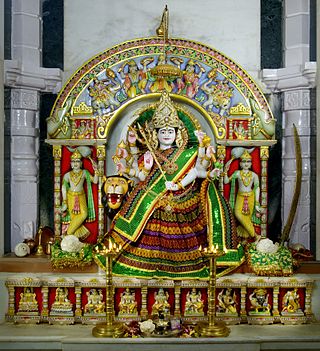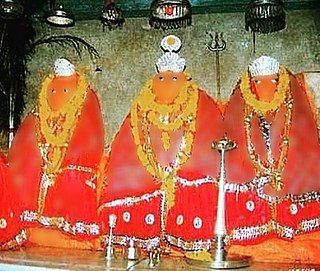
Chauhan, a name derived from the historical Chahamanas, a clan name associated with various ruling Rajput families in the present-day Indian state of Rajasthan from seventh century onwards.

Ashapura Mata is an aspect of Devi, a Hindu goddess. She is one of the kuladevis of Kutch and Rajasthan, and the Jadeja clan of gujarat and Chauhans inhabiting the western indian provinces. She is a goddess regarded to fulfill the wishes of her adherents. In her iconography,

Shakambhari Purnima is a Hindu festival primarily observed in India, celebrating the goddess Shakambhari. It is observed in Paush month, which normally comes in January. Shakambari Purnima is the last day in the 8-day long holiday of Shakambari Navratri. "Most Navratri begins on Shukla Pratipada except for Shakambari Navratri, which begins on Ashtami and ends on Purnima in Paush month.".

The Chahamanas of Shakambhari, colloquially known as the Chauhans of Sambhar or Chauhans of Ajmer, were an Indian dynasty that ruled parts of the present-day Rajasthan and neighbouring areas in India, between the 6th and 12th centuries. The territory ruled by them was known as Sapadalaksha. They were the most prominent ruling family of the Chahamana (Chauhan) Rajput clan.
The Chahamanas of Naddula, also known as the Chauhans of Nadol, were an Indian dynasty. They ruled the Marwar area around their capital Naddula between 10th and 12th centuries. They belonged to the Chahamana (Chauhan) clan of the Rajputs.
Vakpatiraja I, also known as Vappayaraja, was an Indian king belonging to the Shakambhari Chahamana dynasty. He ruled the Sapadalaksha country, which included parts of present-day Rajasthan in north-western India. He appears to have made an attempt to throw off the Gurjara-Pratihara overlordship, and was the first Chahamana king to assume the title Maharaja.
Chamundaraja was an Indian king belonging to the Shakambhari Chahamana dynasty. He ruled the Sapadalaksha country, which included parts of present-day Rajasthan in north-western India.

Lakshmana also known as Raval Lakha or Lakhana was an Indian king who established the Naddula Chahamana dynasty. A son of the Shakambhari Chahamana king Vakpatiraja I, Lakshmana carved out a principality around Naddula.
Vigraha-pāla was an Indian king belonging to the Naddula Chahamana dynasty. He ruled the area around Naddula.
Mahindu, also known as Mahendra or Mahindra, was an Indian king belonging to the Naddula Chahamana dynasty. He ruled the area around Naddula.
Ahila was an Indian king belonging to the Naddula Chahamana dynasty. He ruled the area around Naddula. He defeated the Chaulukya invader Bhima I.
Anahilla was an Indian king belonging to the Naddula Chahamana dynasty. He ruled the area around Naddula. He defeated the Chaulukya king Bhima I, defeated a general of the Paramara king Bhoja, and also defended his territory against the Ghaznavids.
Jendraraja was an Indian king belonging to the Naddula Chahamana dynasty. He ruled the area around Naddula, and achieved military successes against the Chaulukyas.
Prithvi-pala was an Indian king belonging to the Naddula Chahamana dynasty. He ruled the area around Naddula. He achieved military successes against the Chaulukyas, the Paramaras of Vagada, and a Ghaznavid raider.
Jojalla-deva was an Indian king belonging to the Naddula Chahamana dynasty. He ruled the area around Naddula. The Chahamana records claim that he invaded the Chaulukya kingdom, and occupied their capital Anahilapataka.
Asharaja was an Indian king belonging to the Naddula Chahamana dynasty. He ruled the area around Naddula, before being dethroned by his nephew Ratnapala. He then accepted the suzerainty of his family's rival, the Chaulukya king Jayasimha Siddharaja. He participated in Jayasimha's successful war against the Paramara king Naravarman. His son Katukaraja seized the Naddula throne after his death.
Alhana-deva was an Indian king belonging to the Naddula Chahamana dynasty. He ruled the area around Naddula, as a vassal of the Chaulukya king Kumarapala. During his reign, the Chahamanas of Shakambhari invaded Naddula, and Kumarapala replaced him with his own governors. Later, Kumarapala restored his rule in Naddula, as a result of his service in Chaulukya military campaigns.
Kelhana-deva was an Indian king belonging to the Naddula Chahamana dynasty. He ruled the area around Naddula, as a Chaulukya vassal. He participated in the 1178 CE Battle of Kasahrada, in which the Chaulukya forces defeated the Ghurid ruler Muhammad of Ghor.
Jayata-simha was an Indian king belonging to the Naddula Chahamana dynasty. He ruled the area around Naddula. He was probably defeated by the Ghurid general Qutb al-Din Aibak, and the Naddula kingdom disintegrated after his death.
Rawal Jaitrasimha also known as Rawal Jaitra Singh was the ruler of the Guhila dynasty from 1213 to 1252. During his rule, the Guhila Kingdom attained a high political status. Ekalinga Mahatmya mentions his title as Rajakula (Rawal), his own inscriptions call him a Maharajadhiraja.







